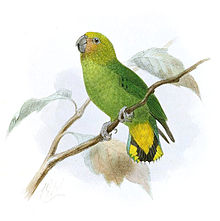| Yellow-capped pygmy parrot | |
|---|---|

| |
| Female; illustration by Keulemans | |
| Conservation status | |
 Least Concern (IUCN 3.1) | |
| Scientific classification | |
| Domain: | Eukaryota |
| Kingdom: | Animalia |
| Phylum: | Chordata |
| Class: | Aves |
| Order: | Psittaciformes |
| Family: | Psittaculidae |
| Genus: | Micropsitta |
| Species: | M. keiensis |
| Binomial name | |
| Micropsitta keiensis (Salvadori, 1876) | |
The yellow-capped pygmy parrot (Micropsitta keiensis) is a species of parrot in the family Psittacidae mainly found throughout western New Guinea. Its natural habitats are subtropical or tropical moist lowland forest, subtropical or tropical mangrove forests, and subtropical or tropical moist montane forest. Like many parrots, this pygmy parrot is affectionate to its mate. It is currently unknown if they remain monogamous for life like many bigger parrots because of their isolated location, which is difficult to reach.
Description
Adults of both sexes are green, have a yellow crown and undertail coverts, blue central tail feathers and brown eyes. It has three subspecies: the nominate (M. k. keiensis), M. k. chloroxantha and M. k. viridipectus. Juveniles of M. k. keiensis are generally duller in color; the other subspecies are as in adults. Generally, they are approximately 9.5 cm (3.7 in) long and 11-14 g (0.4-0.5 oz) in weight. It is the smallest species of parrot.

References
- BirdLife International (2016). "Micropsitta keiensis". IUCN Red List of Threatened Species. 2016: e.T22684845A93049599. doi:10.2305/IUCN.UK.2016-3.RLTS.T22684845A93049599.en. Retrieved 13 November 2021.
- Yellow-capped Pygmy Parrot (Microspsitta kinensis) | Parrot Encyclopedia
- Smeele, Simeon Q.; Conde, Dalia A.; Baudisch, Annette; Bruslund, Simon; Iwaniuk, Andrew; Staerk, Johanna; Wright, Timothy F.; Young, Anna M.; McElreath, Mary Brooke (2022). "Coevolution of relative brain size and life expectancy in parrots". doi:10.1101/2021.10.28.466243. hdl:1885/294439. Retrieved 2023-12-14.
{{cite journal}}: Cite journal requires|journal=(help)
This article relating to parrots is a stub. You can help Misplaced Pages by expanding it. |